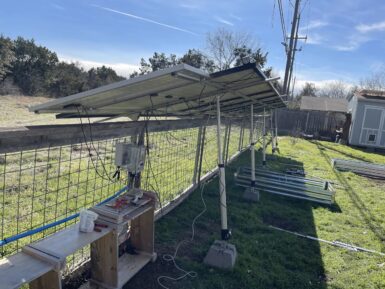
Bluetooth Low Energy 4.0 Module - HM-10
Save 20%Bluetooth 4.0 module (Low Energy) compliant with ISM 2.4 GHz, master/slave operating mode with transparent data transmission, based on the Texas Instruments CC2541 chip with 256K of Flash memory and 8K of RAM.
Overview
This is a Bluetooth 4.0 (Low Energy) module compliant with ISM 2.4 GHz, with master/slave mode of operation and transparent data transmission, based on the Texas Instruments CC2541 chip with 256K Flash memory and 8K RAM.
It can be controlled through simple AT commands (via UART) or programmed with custom applications. Ideal for use in projects where Bluetooth connection is needed, such as between microcontroller and PC. Power supply ranges between 2V and 3.6Vdc.
Note: SMT mounting.
Tech specs
- Bluetooth 4.0 module compliant with ISM 2.4 GHz (HM-10)
- Uses Texas Instruments CC2541 SoC chip with 256K Flash memory and 8K RAM
- Supports master and slave modes
- RX standard gain: 19.6 mA
- TX -6 dBm: 24 mA
- Frequency: 2402 - 2483.5 MHz in 20 kHz steps
- Modulation and Data Rate: 1 Mbps, GFSK
- Number of channels: 40
- Output power: -23 to 4 dBm
- Reception sensitivity: -93dBm/-87dBm
- Stack: ATT, GATT, SMP, L2CAP, GAP
- Range: over 70 meters 10-bit ADC
- Serial interface: UART/SPI Wake-up interrupt, Watchdog Timer
- AES Security Coprocessor
- Power supply: ranges between 2V and 3.6V
- VDD ripple: 100mV max
- Current consumption (at 25°C with VDD = 3V):
- Power Mode 3 (External Interrupts): 0.4uA
- Power Mode 2 (SleepTimerOn): 0.9uA
- Power Mode 1 (3-μs Wake-Up): 235uA
- RX Standard Gain: 19.6mA
- TX -6 dBm: 24mA
- TX 0 dBm: - - Operating temperature: -40°C to +85°C
- Dimensions (mm): 27x13x1.6
- Weight: 5 grams.
Conformities
Get Inspired

Build a cool display with the Arduino Giga Display - showcases using LVGL to show a graph of the on board mic, imu sensor and rgb led

The EV (electric vehicle) versus ICE (internal combustion engine) debate is more complicated that it may seem, but one fact is quite simple: it is much easier to generate electricity at home than it is to refine fossil fuels. This means that it is possible power a vehicle for free after the initial investment. But doing so takes quite a lot of hardware, which is why Shawn Murphy developed this charging system controlled by an Arduino GIGA R1 WiFi. Murphy owns a Ford Lightning electric pickup truck, which is inefficient by EV standards thanks to its weight. But even at just two miles per kWh of electricity, he estimates that he can break even on the cost of his solar charging system within four to five years. After that, the electricity to power the Ford will, essentially, be free. Any excess energy can power his home or feed back into the grid. Just powering the truck alone will require a lot of electricity, so Murphy acquired 10 used 360-watt solar panels. Those feed to a battery backup array, which supplies power to the Ford charging station. To maximize efficiency, Murphy wants the solar panels to pivot on one axis to follow the sun. He estimates that will increase their output by 20-25% throughout the day, which is a significant amount of energy with a solar panel array this large. An Arduino GIGA R1 WiFi board controls the tilt of the panels via linear actuators. Murphy originally used “dumb” actuators, but is switching to “smart” models from Progressive Automations that include positional feedback through Hall effect sensors. A GIGA Display Shield gives Murphy access to an interface, which he can also access through the Arduino Cloud. In addition to controlling the linear actuators, the Arduino monitors power generation and consumption. This is still a work in progress as Murphy continues to make improvements, but he’s well on his way to “free” energy for his truck.





